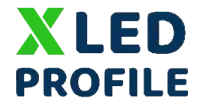Was die Wahl des Clipmaterials auf der Rückseite des LED-Aluminiumprofils anbelangt, so haben transparente Kunststoff- und Metallmaterialien ihre eigenen Merkmale.
Die wichtigsten Unterschiede sind die folgenden Aspekte:
Langlebigkeit und Stärke:
Metallklammern (wie Aluminiumlegierung, Edelstahl)
Vorteile: Hohe Zugfestigkeit, Verschleißfestigkeit, nicht leicht zu verformen nach langfristigem Gebrauch, geeignet für tragende oder häufige Demontage Szenarien.
Nachteilig: Die Lebensdauer kann durch Metallermüdung oder Oxidation (z. B. Rost bei rostfreiem Stahl) beeinträchtigt werden, und das Gewicht ist etwas höher.
Transparente Kunststoffklammern (PC, ABS)
Vorteile: geringes Gewicht, gute Schlagfestigkeit (insbesondere bei niedrigen Temperaturen), Isolierung und kein Korrosionsrisiko
Nachteilig: Langfristige Einwirkung von ultravioletten Strahlen kann zu Alterung und Sprödigkeit führen, und die Tragfähigkeit ist gering.
Anpassungsfähigkeit an die Umwelt
Metall: Hohe Temperaturbeständigkeit (z. B. bei hohen Temperaturen im Freien), aber die Leitfähigkeit kann in feuchten Umgebungen gefährdet sein.
Kunststoff: Säure- und alkalibeständig, nicht leitend, geeignet für feuchte oder chemische Umgebungen, kann jedoch bei hohen Temperaturen erweichen (PC hat eine Temperaturbeständigkeit von etwa 120°C, ABS von etwa 80°C)
Installation und Wartung
Matel-Clips: erfordern in der Regel Werkzeuge zur Montage (z. B. Schrauben), die sich etwas mühsam wieder entfernen lassen, aber die Verbindung ist stabiler
Kunststoff-Clips: Die meisten von ihnen verwenden Clips, die einfach zu installieren sind (Handbetrieb) und sich für eine schnelle Konstruktion eignen, aber durch wiederholte Demontage locker werden können.
Kosten und Ästhetik:
Kunststoff: kostengünstig, transparentes Design kann besser verborgen werden, geeignet für Anlässe mit hohen ästhetischen Anforderungen,
Metall: Teurer, aber industriell anmutender, geeignet für High-End- oder Schwerlastanwendungen.
Besondere Bedürfnisse:
Isolierung: Kunststoffe sind für Szenarien mit hohen elektrischen Sicherheitsanforderungen geeignet.
Wärmeleitfähigkeit: Metall kann indirekt zur Wärmeableitung beitragen, hat aber nur begrenzte Auswirkungen auf die Wärmeableitung von LEDs.
